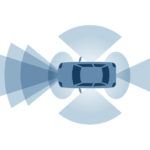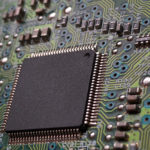 Renesas Electronics Corporation introduced the newest device in its Automotive HD Link (AHL) portfolio that enables automotive manufacturers to deliver high-definition video over low-cost cables and connectors. The new RAA279974 4-channel AHL video decoder processes four input sources simultaneously, making it an economical solution for surround-view and multi-camera applications.
Renesas Electronics Corporation introduced the newest device in its Automotive HD Link (AHL) portfolio that enables automotive manufacturers to deliver high-definition video over low-cost cables and connectors. The new RAA279974 4-channel AHL video decoder processes four input sources simultaneously, making it an economical solution for surround-view and multi-camera applications.Renesas’ AHL technology uses a modulated analog signal to transmit video. The frequency is therefore 10 times lower than digital transmission solutions available in the market today (~37MHz vs. >3GHz), making it robust against noise and enabling longer transmission distances (20-30m) with unshielded twisted pair cables and standard connectors. Existing standard-definition analog video cables and connectors can also be employed. Using unshielded twisted pair cables not only reduces cost, but it is also easier to route through the vehicle and offers lighter weight for improved energy efficiency and performance. Digital links such as SerDes require heavily shielded cables and high-end connectors that cost significantly more than those for AHL and may require replacement after five to seven years.
The RAA279974 completes the AHL family of products which consists of the RAA279971, single channel AHL video encoder, and the RAA279972, a single channel AHL video decoder. The RAA279974 is an important addition to the AHL family as most OEMs want to support multiple cameras in vehicles for applications such as surround-view parking assistance monitors. AHL can be paired with R-Car Automotive SoCs, RH850 MCUs, automotive PMICs, and analog components to cost-effectively implement numerous safety features in virtually any vehicle. Renesas provides multiple Winning Combinations that combine these components to enable manufacturers to quickly implement pre-tested video designs.
AHL is robust against noise and offers excellent picture quality. There is no noticeable difference in picture quality when compared to a pure digital video image. Due to the fundamental nature of an analog signal, an AHL video transmission can withstand noise and interference. The picture may degrade slightly, but there will still be a live image to view. With a digital link, any noise/interference will result in a complete loss of picture.
Key Features of AHL include: Supports resolutions from VGA up to 720p/60 or 1080p/30 for flexibility to implement non-standard vertical resolutions (not just the TV video standard 16:9 resolutions); MIPI-CSI2, BT656, & DVP inputs and outputs provide a flexible interface to support a variety of image sensors; AHL does not require compression like an Ethernet system does, so it has no latency in the video; Requires only 27MHz crystal clock, with internal PLLs able to generate the necessary clock frequencies for higher resolutions, reducing cost; AHL has passed BCI & CISPR25 EMC/EMI testing using UTP cables; MIPI-CSI2 output with Virtual Channel allows 4 channels of video to be sent over a single data bus interface to the SoC (saves input ports on the SoC);
The four-channel RAA279974 AHL decoder samples and evaluation boards are available today. Renesas also offers the RTKA279974ZK0000BU Camera Kit Bundle evaluation system which includes four AHL cameras integrated with the RAA279971 AHL encoder.
You may also like:
Filed Under: Automotive, Connectors, News, Products






Questions related to this article?
👉Ask and discuss on Electro-Tech-Online.com and EDAboard.com forums.
Tell Us What You Think!!
You must be logged in to post a comment.